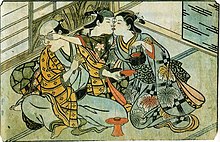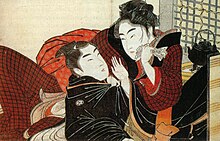Kagema

Kagema (陰間) is a historical Japanese term for young male prostitutes. Kagema were often passed off as apprentice kabuki actors (who were themselves often prostitutes on the side) and catered to a mixed male and female clientele. For male clients, the preferred service was anal sex;[1]: 109 homosexual fellatio is almost unmentioned in Tokugawa-era documents.[1]: 121–122 This is based on the understanding that some men enjoyed anal stimulation based solely on physical, not emotional grounds. The belief that the anus is a center of sexual energy most likely originates within Chinese texts.[1] Kagema who were not affiliated with an actual kabuki theatre could be hired through male brothels or those teahouses specializing in kagema.[1]: 69–72 Such institutions were known as Kagemajaya. Kagema typically charged more than female prostitutes of equivalent status,[1]: p111 and associated notes and did a healthy trade into the mid-19th century despite increasing legal restrictions.[1]: 70–78, 132–134 This increased interest in kagema owes itself in part to the increased presence of samurai within cities. The garrisoning of thousands of Samurai in the early 17th century not only brought the male-love tradition of nanshoku to the common people, but also dramatically shifted the ratio of man to woman (170 men for every 100 women) which obviously limited the sexual possibilities available to young men; encouraging the spread of nanshoku among middle class men. However, it is important to note that despite the sexual restrain the Tokugawa Shogunate tried to initiate, they too often took nanshoku lovers. Kagema themselves were immensely popular with the merchant class and wealthy elite of the Edo period, who indulged a debauched form of nanshoku.[2] Many such prostitutes, as well as many young kabuki actors, were indentured servants sold as children to the brothel or theatre, typically on a ten-year contract.[1]: 69, 134–135 Kagema could be presented as young men (yarō), wakashū (adolescent boys, about 10–18 years old) or as onnagata (female impersonators).[1]: 90–92 However, the increasing commercialization of homosexuality (in addition to increased western influences) that kagema prostitutes caused, assisted in the moral degradation of nanshoku. Rather than representing a form of masculine selflessness, nanshoku became associated with moral stagnancy caused by urban entertainment districts.[3]


This term also appears in modern Japanese homosexual slang.
References
- ^ a b c d e f g h Leupp, Gary P. (1997). Male Colors: The Construction of Homosexuality in Tokugawa Japan. University of California Press. ISBN 0-520-20900-1.
- ^ Neil, James (2009). The Origins and Role of Same-Sex Relations In Human Societies. McFarland. ISBN 0-7864-3513-5.
- ^ Neil, James (2009). The Origins and Role of Same-Sex Relations In Human Societies. McFarland. ISBN 0-7864-3513-5.
Bernard Faure "The Red Thread" 1998.
